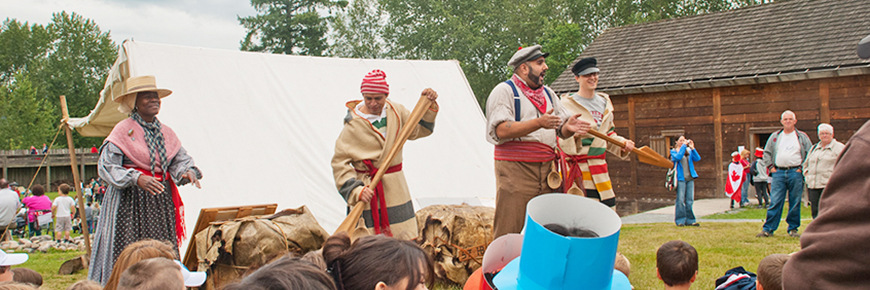
History
Fort Langley National Historic Site
Faces from Fort Langley’s History
Built in 1827, Fort Langley was a Hudson’s Bay Company fur trading post. Located on the banks of the Fraser River, it was once part of a trade route for the British Empire at the centre of a large population of Indigenous people.
Partners in Business and Marriage
Fort Langley drew Indigenous people who traded furs and fish for blankets and other goods. To strengthen its position, the Hudson’s Bay Company (HBC) encouraged its men to marry Indigenous women. These alliances allowed the HBC access to Indigenous trade networks, and the fort prospered. They also gave Indigenous families priority access to the European resources for sale at the fort.
A Trade Off: Losing Money, Winning a Monopoly
HBC Governor George Simpson had a problem. He wanted furs from coastal Indigenous people, but so did the Americans. The convenience of a permanent trading post (Fort Langley) or a roving one (the SS Beaver) didn’t sway savvy Indigenous traders. They wanted the best deal. Simpson’s solution? Drive the price down, way down. The HBC lost money, but they won the trade.
More Than a Fur Trading Post
While the HBC came looking for furs, the Kwantlen people had other business ideas. Chief Whattlekainum pressed the Company traders to accept salmon and cranberries. Soon salted salmon was shipped to Hawaii and cranberries to California.
These new products posed a challenge for storage and shipping. William Cromarty, Peopeo and other coopers made wooden barrels to export goods, a key to the fort’s success.
Indigenous workers were hired for the Fort Langley farm. Fort Langley not only became self-sufficient for food and supplied other posts, but it exported produce to the Russian American Company in Alaska. Through this special contract the HBC finally gained a monopoly on the coastal trade.
Fort Langley: North of the Border
In 1846, the border with the United States was settled. Now that the line was drawn, the HBC needed to keep its trade goods in British territory, north of the border. Fort Langley was ideally positioned as the link between the interior HBC posts and the Pacific Ocean (and ultimately Britain). Soon, fur brigades were coming and going, delivering furs to Fort Langley and leaving with trade goods and provisions for the remote posts.
Claims, Colony, Country
“Gold!” In 1858, the discovery of this glittery mineral on the Fraser River changed everything. Fort Langley went from a modest trade and provisioning post to the centre of a gold rush as 30,000 miners came calling.
Fearful of an American takeover of the resource-rich region, the British government quickly made a move. Right here, on November 19, 1858, the newly-sworn-in Governor James Douglas proclaimed the Colony of British Columbia.
Eight years later, in 1866, the Colony of British Columbia merged with the Colony of Vancouver Island, with Victoria as the capital. Then, in 1871, British Columbia became a province of Canada.
Fort Langley: Part of Canada’s Heritage
Over time, business at Fort Langley declined as British Columbia grew and changed around it. In recognition of its importance in the story of Canada, Fort Langley became a national historic site in 1923. And in 1931, the one remaining original building was opened to the public.
Starting in the 1950s, many buildings were added to restore the atmosphere of the original fort. Today, Fort Langley National Historic Site is part of a nation-wide family of protected areas managed by Parks Canada. Canada’s national parks, national historic sites and national marine conservation areas help tell the story of Canada.
- Date modified :